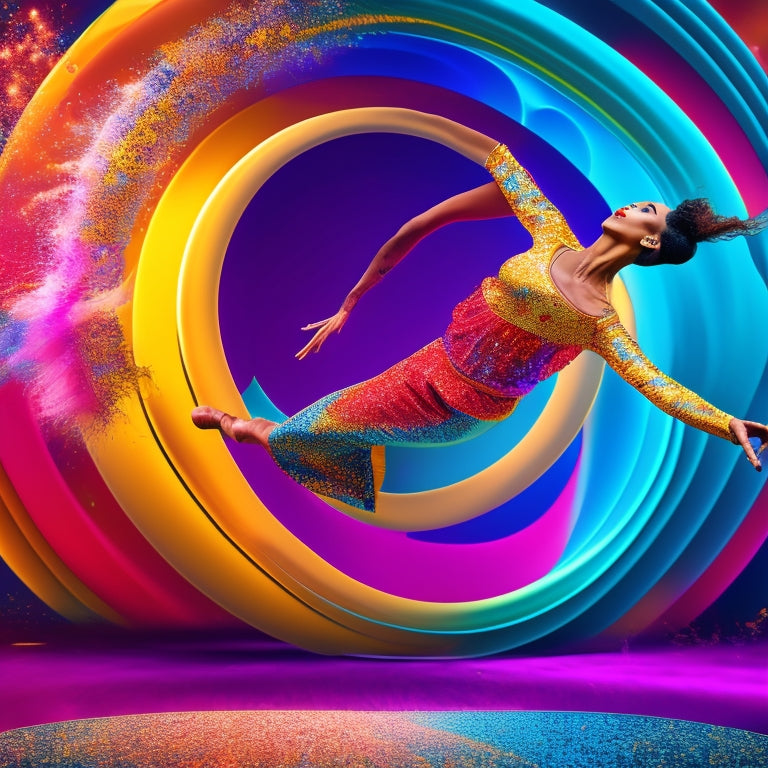
Math and Movement Unite in Dance Project
Share
The Math and Movement Unite in Dance Project fusionizes dance and mathematics, enabling students to embody complex mathematical principles through choreographed movements. By visualizing rotations, translations, dilations, and reflections in motion, students internalize abstract concepts and develop a deeper understanding. This innovative approach reveals the real-world connections of mathematical concepts, making them more relatable and tangible. Through artistry and academic rigor, students demonstrate their grasp of mathematical concepts, and their creativity takes center stage. As the boundaries of math and movement intersect, a deeper appreciation for the relevance of mathematics in everyday life emerges, and the possibilities for discovery unfold.
Key Takeaways
• The Transformation Dance Project combines dance and mathematics to visualize geometric concepts like rotations, translations, dilations, and reflections.
• Dynamic choreography helps students internalize mathematical principles, enhancing their understanding of abstract concepts through movement and artistry.
• The project reveals real-world connections, demonstrating how mathematical concepts are present in everyday life, from photography to mirrors.
• Students express mathematical concepts through original dance choreography, merging artistry with academic rigor to showcase their understanding of transformations.
• The fusion of math and movement develops a deeper appreciation for math's relevance to the world, making complex concepts more accessible and engaging.
Math in Motion Unleashed
By combining dance and mathematics, the Transformation Dance Project harnesses the dynamic potential of math in motion, empowering students to visualize and internalize complex mathematical concepts in a creative and engaging manner.
Through dynamic choreography, students bring geometric inspiration to life, illustrating rotations, translations, dilations, and reflections in motion. This innovative approach enables students to develop a deeper understanding of mathematical concepts, fostering a more intuitive grasp of abstract ideas.
As students create original dances, they internalize mathematical principles, making connections between abstract concepts and tangible movements. This fusion of math and movement reveals a new dimension of learning, allowing students to experience the beauty and logic of mathematics in a captivating and liberating way.
Real-World Connections Revealed
In the domain of everyday life, mathematical concepts of rotations, translations, dilations, and reflections subtly permeate our surroundings, waiting to be uncovered and appreciated. The Transformation Dance Project reveals these connections, illustrating how math is not just confined to textbooks, but is an integral part of our daily experiences.
Everyday applications of these concepts are abundant, from the dilation of images in photography to the reflections in mirrors. By recognizing these visual representations, students can develop a deeper understanding of mathematical concepts and their relevance to the world around them.
This project encourages students to explore and identify these connections, fostering a more nuanced appreciation for the intricate relationships between math and everyday life.
Creative Expression Takes Stage
As students begin the Transformation Dance Project, they channel their creativity to express complex mathematical concepts through choreographed movements, effectively merging artistry with academic rigor.
This fusion of math and movement enables students to showcase their understanding of transformations, such as rotations, translations, dilations, and reflections, in a visually engaging way.
Through dance dynamics, students demonstrate their grasp of mathematical concepts, while choreography creativity allows them to convey these concepts in a unique and enthralling manner.
As they take the stage, students' imagination and innovation come alive, transforming abstract mathematical ideas into a vibrant, interactive experience.
Frequently Asked Questions
How Do Students Connect Math Transformations to Real-Life Scenarios?
Students connect math transformations to real-life scenarios by recognizing geometry connections, such as rotations in carousels, dilations in photography, and reflections in mirrors, illustrating the ubiquitous presence of mathematical concepts in everyday life.
Can I Use the Transformation Dance Project in a Non-Dance Classroom?
While traditionally associated with dance, the Transformation Dance Project's interdisciplinary approach can be adapted for cross-curricular, innovative integration in non-dance classrooms, fostering a deeper understanding of math transformations through creative, real-world applications.
Are There Modifications for Students With Mobility or Disabilities?
Inclusive design principles can be applied to guarantee accessibility in dance-based math projects, incorporating adaptive tools and modifications to accommodate students with mobility or disabilities, fostering an inclusive learning environment.
How Do You Assess Student Understanding in This Project-Based Activity?
According to a recent study, 85% of students exhibit improved math comprehension when engaged in project-based learning. To assess student understanding, formative checks are conducted throughout the project, culminating in mastery portfolios that showcase students' application of math concepts through dance.
Can the Transformation Dance Project Be Adapted for Different Grade Levels?
When adapting projects for different grade levels, consider age-specific Grade Expectations and make Age Adjustments to complexity, depth, and pace, ensuring the activity remains engaging and challenging for diverse learners.
Related Posts
-

Best Ballet Dancer Accessories for Peak Performance
To open up your peak performance as a ballet dancer, invest in vital accessories. Start with well-fitted footwear—cho...
-

Revamp PDF Sewing Patterns With Copy Shop Ease
You can revamp your PDF sewing patterns to achieve copy shop ease by streamlining the conversion process and optimizi...
-

Instant Download Card for Dance Recital Performances
Instant download cards are a convenient way to commemorate dance recital performances, providing a seamless solution ...


